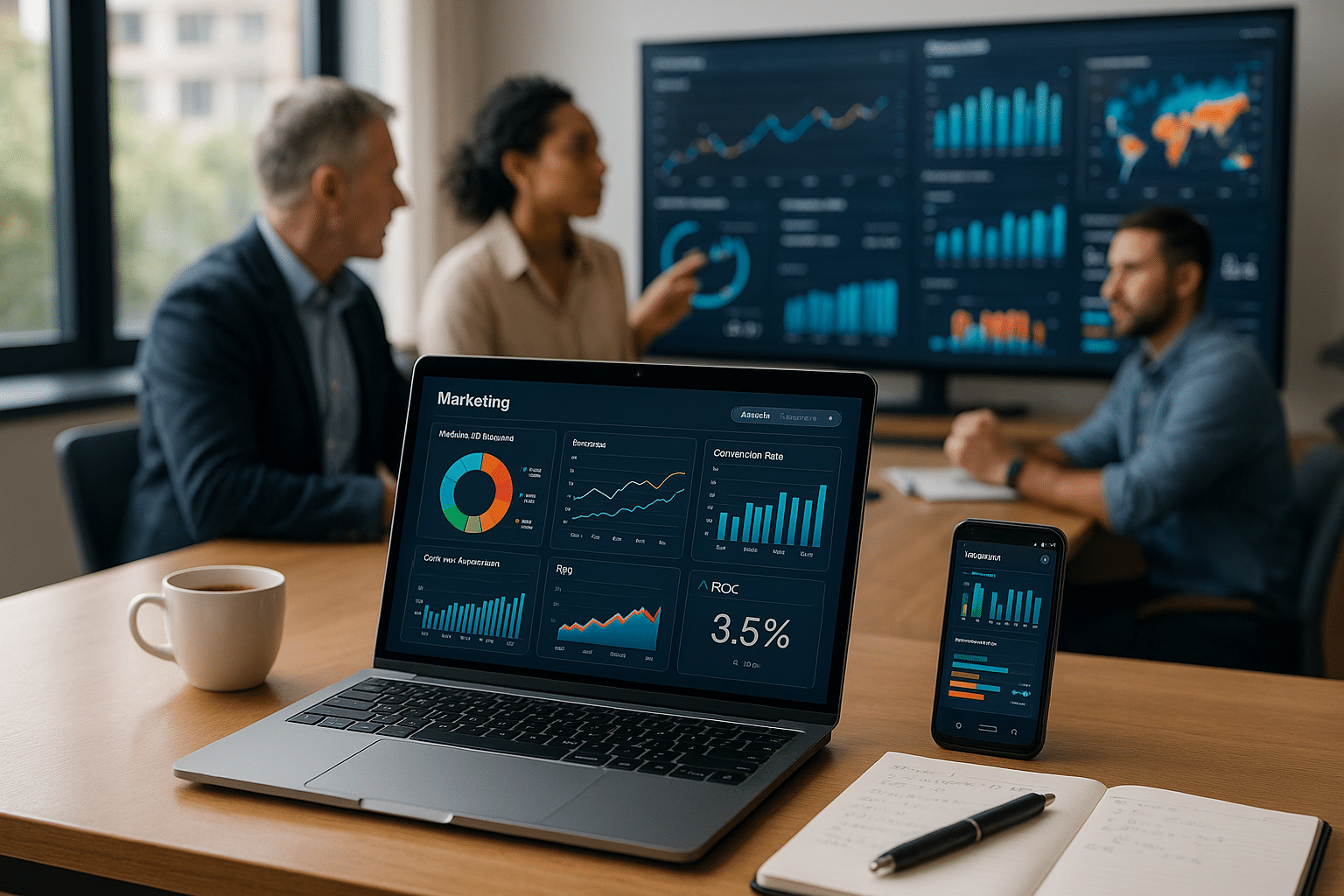If you are a marketer, entrepreneur, or business owner, chances are you are dealing with this scenario daily. But, what if I tell you there’s a powerful tool that can simplify this daunting task? Yes, I’m talking about dashboards – a vital tool for real-time ROI monitoring and maximizing marketing success. 😎
First off, dashboards are not just glorified excel spreadsheets or a fancy term for a data display. These are powerful, interactive platforms that provide a comprehensive view of your data. With dashboards, you can monitor your key performance indicators (KPIs), track your return on investment (ROI), and even predict future trends. And, the most appealing part? All of this can be done in real-time. 🚀
Why Should You Care About Dashboards?
Well, imagine trying to navigate a bustling city without a map or GPS. Sounds stressful, right? That’s what it’s like managing a marketing campaign without a dashboard. With the right dashboard, you’re equipped with a roadmap for your marketing strategy, helping you to navigate the complex landscape of digital marketing with ease.
Furthermore, dashboards offer real-time data. This means you can spot trends as they are happening, not after the fact. This allows for timely adjustments, ensuring that your marketing efforts are always aligned with your business goals. Essentially, a dashboard acts as your co-pilot, ensuring you’re on the right path, and alerting you if you start to drift. 🧭
Understanding the Power of Dashboards for Real-Time ROI Monitoring
In this article, we will be exploring how dashboards can help you harness your marketing efforts for maximized success. We will delve into the different types of dashboards, their functions, and how you can utilize them to optimize your marketing strategy. We’ll also discuss the best practices for creating an effective dashboard, ensuring that you get the most out of this powerful tool.
Get Ready for a Deep Dive
By the end of this read, you should have a clear understanding of how dashboards can serve as your control panel for marketing success. You’ll have insights on how to leverage dashboards for real-time ROI monitoring, allowing you to make data-driven decisions that will steer your business in the right direction. 📊
We’ll also explore case studies where dashboards have proven to be game-changers for businesses, giving you real-world examples of their transformative power. Plus, we’ll provide you with actionable tips and strategies that you can implement right away.
So, buckle up, and get ready for an insightful journey into the world of dashboards. Whether you’re a seasoned marketer or a newbie, there’s something here for you. Let’s dive in and uncover the power of dashboards for maximizing marketing success! 🏁
🚀 Embrace the Power of Dashboards for Real-Time Marketing ROI Monitoring
As a technical expert in software engineering and an avid enthusiast of marketing strategies, I’m fascinated by the transformative power of data dashboards in real-time marketing ROI monitoring. Dashboards, which were once solely the purview of IT departments, have become indispensable tools in the arsenal of modern marketers.
With the advent of advanced analytics and the ease of data access, marketing professionals are now empowered to make data-driven decisions. Dashboards deliver real-time insights into marketing performance and, crucially, return on investment (ROI) – an essential gauge of success in any marketing endeavor.
In this in-depth exploration, we will dissect how dashboards contribute to maximizing marketing success. We will delve into the power of real-time ROI monitoring, present comparisons of various dashboard platforms, and recommend resources for mastering this essential tool. So, let’s dive in!
📊 Understanding the Role of Dashboards in ROI Monitoring
In the realm of marketing, dashboards serve as centralized platforms that gather, organize, and present data from multiple sources in an easy-to-understand format. These tools offer real-time views into a myriad of marketing metrics, thereby providing instant insights into campaign performance, audience engagement, and overall ROI.
Importantly, dashboards are not merely data visualizers. They are potent analytical tools that reveal trends, highlight successes and failures, and guide future strategies. In the context of ROI, they provide a real-time pulse check, enabling marketers to promptly tweak underperforming campaigns, thereby preventing financial losses.
To further illustrate the significance of dashboards, let’s delve into a comparison of popular dashboard platforms used in ROI monitoring.
🔍 Comparison of Dashboard Platforms for ROI Monitoring
Not all dashboard platforms are created equal. They come with different features, strengths, and limitations. Here, we provide a comparative analysis of popular dashboard platforms used in ROI monitoring: Google Data Studio, Tableau, and Microsoft Power BI.
| Platform | Features | Strengths | Limitations |
|---|---|---|---|
| Google Data Studio | Data visualization, real-time reports, customizable dashboards | Free to use, seamless integration with Google products | Limited data connectors, requires scripting for advanced functions |
| Tableau | Advanced data visualization, real-time reports, extensive data connectors | Highly interactive dashboards, powerful analytical capabilities | Steep learning curve, relatively expensive |
| Microsoft Power BI | Data visualization, real-time reports, AI-powered insights | Intuitive user interface, robust integration with Microsoft products | Limited customization, less flexible compared to Tableau |
As you explore these platforms, I recommend watching “Choosing the Right Dashboard Platform” by CSG Pro on YouTube. This video offers valuable insights into selecting a dashboard platform that best fits your marketing needs.
🧩 Harnessing Dashboards for Data-Driven Marketing Decisions
Now that we understand the role of dashboards and the differences among popular platforms, let’s delve into how marketers can harness these tools for data-driven decisions.
First and foremost, dashboards provide a holistic view of marketing activities. By centralizing data from various channels – social media, email campaigns, website analytics, etc. – marketers can obtain a unified understanding of their efforts. This comprehensive view is crucial for assessing the effectiveness of multi-channel strategies and optimizing ROI.
Second, dashboards facilitate data democratization. This means making data accessible and understandable to all members of a marketing team, regardless of their technical skills. As a result, everyone can contribute to data-driven decision-making, leading to more innovative strategies and solutions.
💡 Real-Time ROI Monitoring: The Game-Changer in Marketing Success
One of the most potent features of dashboards is real-time ROI monitoring. This functionality enables marketers to track the financial impact of their strategies as they unfold. If a campaign is not generating the expected ROI, marketers can promptly identify this issue and make necessary adjustments. This agility in decision-making can significantly enhance marketing success.
So, how exactly does real-time ROI monitoring work? The dashboard continuously pulls data from various sources and updates the ROI metrics in real-time. Marketers can set up alerts for specific thresholds, ensuring that they’re instantly notified of significant changes.
To master real-time ROI monitoring, I highly recommend the YouTube video “Real-Time ROI Monitoring with Google Analytics” by Loves Data. This tutorial provides step-by-step instructions on setting up real-time ROI tracking using Google Analytics, a useful skill for any marketer.
🎯 Implementing Dashboards for Optimal ROI Monitoring
As we’ve explored, dashboards are incredibly powerful tools for ROI monitoring. However, their effectiveness is dependent on proper implementation. So, how can marketers ensure they’re using dashboards to their full potential?
First, it’s crucial to determine what metrics are most relevant to your marketing objectives. While dashboards can track an extensive range of data, not all metrics may be relevant to your specific goals. By focusing on key performance indicators (KPIs), you can ensure that your dashboard is a useful tool for decision-making.
Secondly, designing an intuitive and visually engaging dashboard is key. Dashboards should be easy to navigate and interpret, with clear labels and visual cues. The design should draw attention to critical data and trends, enabling quick interpretation and decision-making.
🛠️ Customizing Your Dashboard for Maximized Marketing Success
Finally, customizing your dashboard can greatly enhance its utility. Most dashboard platforms offer extensive customization options, allowing you to tailor your dashboard to your unique marketing needs. From creating custom data filters to designing unique visualizations, the possibilities are endless.
However, customization should not come at the expense of simplicity. A cluttered, overly complex dashboard can be more hindrance than help. Striking a balance between customization and simplicity is key to creating an effective dashboard.
For tips on customizing your dashboard, check out the YouTube video “How to Customize Your Dashboard for Greater Marketing Insights” by MeasureSchool. This tutorial offers practical advice on tailoring your dashboard for maximum marketing success.
In conclusion, dashboards are powerful tools for maximizing marketing success. By harnessing their capabilities for real-time ROI monitoring and data-driven decision-making, marketers can transform their strategies and elevate their results. So, why not start harnessing the power of dashboards today?

Conclusion
In conclusion, we’ve embarked on a comprehensive journey through some of the most crucial aspects of Information Technology and engineering. It has been an endeavor aimed at providing you, the reader, with a detailed understanding of these complex areas, and I hope that I’ve succeeded in rendering them more comprehensible.
We started off by exploring the fundamental principles of software engineering, a discipline that combines science, mathematics, and engineering to design and construct software systems that are reliable, efficient, and affordable. The ever-evolving nature of this field emphasizes the need for continuous learning and skill enhancement in order to stay relevant and competitive in the industry. 💻👨💻
Our discussion then moved onto the realm of Information Technology, focusing on its multidimensional impact on various sectors. We delved into topics such as data management, network security, and cloud computing, demonstrating their pivotal roles in shaping the digital landscape of the 21st century. The interplay between IT and engineering was also highlighted, shedding light on how these two disciplines synergize to drive innovation and transformation. 🌐💡
Throughout this discourse, the importance of technical writing in communicating these intricate concepts effectively was reiterated. As a technical writer with a background in Software Engineering, I can attest to the challenge and gratification that comes with elucidating complex ideas in a simple and understandable manner. The ability to do so not only enhances knowledge dissemination but also fosters a culture of inclusivity and diversity in these technical fields. 📝📘
I hope that this article has not only enriched your knowledge but also inspired you to delve deeper into these fascinating fields. Whether you’re a professional seeking to augment your skills, a student contemplating a career in IT or engineering, or simply an enthusiast eager to understand the technological world around you, there’s always something new to learn and explore.
I encourage you to share this article with your colleagues, friends, or anyone who might benefit from it. Feel free to leave a comment below, sharing your thoughts, questions, or any relevant experiences. Your feedback is invaluable in helping me provide content that is relevant and engaging. 🙌🌟
For further reading, I recommend the following resources:
1. “Introduction to Software Engineering” by Ian Sommerville. You can find it here.
2. “Information Technology: The Management Challenge” by Richard T. Watson. Check it out here.
Thank you for taking the time to read this article. I look forward to bringing you more insights into the world of IT and engineering in the future. Until then, keep learning, keep exploring, and keep pushing the boundaries of what’s possible. 🚀🌠
Tags: #IT #Engineering #SoftwareEngineering #TechnicalWriting.



